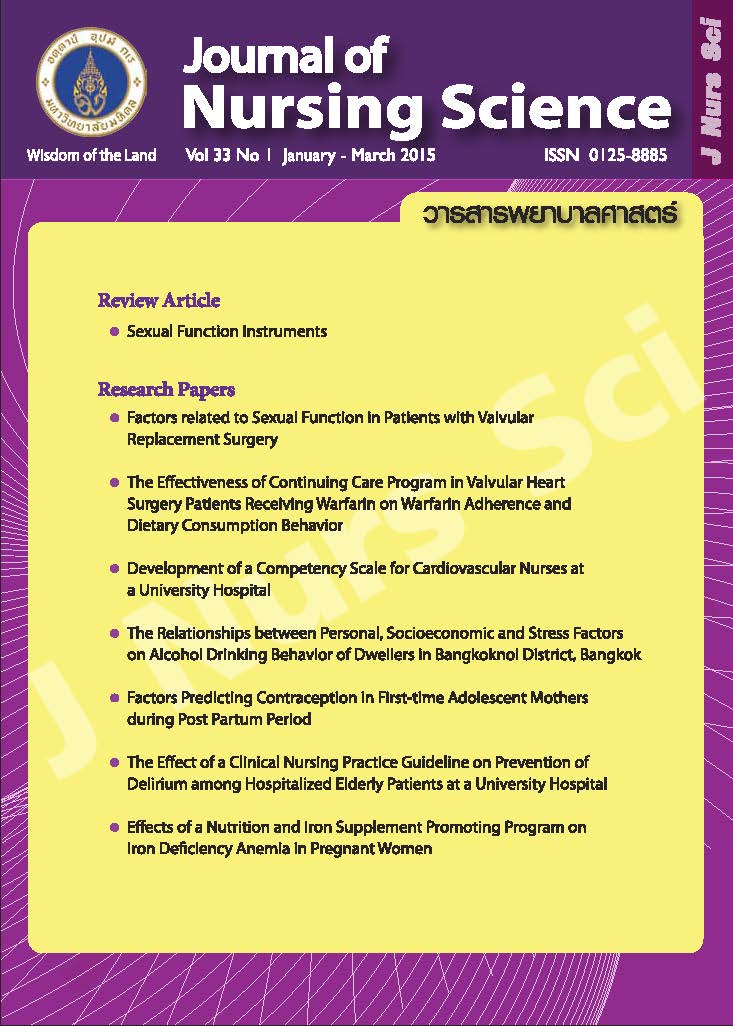Factors related to Sexual Function in Patients with Valvular Replacement Surgery
Main Article Content
Abstract
Purpose: To investigate the correlation of the functional status, intimacy and knowledge of sexual function and sexual function in patients receiving valvular replacement surgery.
Design: A descriptive correlational design.
Methods: The sample group comprised 88 patients after receiving valvular replacement surgery. The samples were collected by using 5 instruments 1) personal data interview and record form 2) daily activity performance interviewing form 3) intimacy questionnaire 4) sexual function questionnaire 5) knowledge of sexual function evaluation form. Descriptive statistics and Spearman’s rank correlation were used for the data analysis.
Main findings: Sexual function in the patients after receiving valvular replacement surgery was in the good level 59.1%, no change 9.1% and the worse level 31.8% compared with their sexual function in the preoperative period. Functional status was positively correlated with sexual function in term of perspectives of the spouse/sexual partners with statistical significance (r = .23, p < .05) but not correlated with the overall scores of sexual function. Intimacy was negatively correlated with sexual function in terms of sexual activity with statistical significance (r = - .22, p < .05), but not correlated with the overall scores of sexual function. Knowledge about sexual function was not correlated with the overall scores of sexual function and each item.
Conclusion and recommendations: According to the findings of the present study, physical function is associated with sexual function in the terms of spouse’s/sexual partner’s perspectives and intimacy was found to be correlated with sexual function in the area of sexual activity with statistical significance. Thus, guidelines should be developed for the care and education of patients and their spouses/sexual partners to cover problems with sexual performance and encourage patients and their spouses/partners to be involved in rehabilitation following surgery.
ปัจจัยที่มีความสัมพันธ์กับการปฏิบัติทางเพศในผู้ป่วยที่ได้รับการผ่าตัดเปลี่ยนลิ้นหัวใจ
บทคัดย่อ
วัตถุประสงค์: เพื่อศึกษาความสัมพันธ์ระหว่างการทำหน้าที่ของร่างกาย ความใกล้ชิดสนิทสนม และความรู้เรื่องการปฏิบัติทางเพศกับการปฏิบัติทางเพศในผู้ป่วยผ่าตัดเปลี่ยนลิ้นหัวใจ
รูปแบบการวิจัย: การศึกษาความสัมพันธ์เชิงบรรยาย
วิธีดำเนินการวิจัย: กลุ่มตัวอย่างเป็นผู้ป่วยที่ได้รับการผ่าตัดเปลี่ยนลิ้นหัวใจ จำนวน 88 ราย เก็บข้อมูลโดยใช้แบบสอบถามและแบบบันทึกข้อมูลส่วนบุคคล แบบสัมภาษณ์ความสามารถในการปฏิบัติกิจวัตรประจำวัน แบบสอบถามความใกล้ชิดสนิทสนม แบบสอบถามความรู้เรื่องการปฏิบัติทางเพศและแบบประเมินการปฏิบัติทางเพศ วิเคราะห์ข้อมูลโดยใช้สถิติพรรณนาและสถิติสัมประสิทธิ์สหสัมพันธ์สเปียร์แมน
ผลการวิจัย: การปฏิบัติทางเพศของกลุ่มตัวอย่างหลังได้รับการผ่าตัดเปลี่ยนลิ้นหัวใจ เมื่อเปรียบเทียบกับการปฏิบัติทางเพศในผู้ป่วยก่อนผ่าตัด มีระดับดีขึ้น ร้อยละ 59.1 ระดับเท่าเดิม ร้อยละ 9.1 และระดับแย่ลง ร้อยละ 31.8 การทำหน้าที่ของร่างกายมีความสัมพันธ์ทางบวกกับการปฏิบัติทางเพศในด้านมุมมองต่อคู่สมรส/คู่นอน อย่างมีนัยสำคัญทางสถิติ (r = .23, p < .05) แต่ไม่มีความสัมพันธ์กับการปฏิบัติทางเพศโดยรวม ความใกล้ชิดสนิทสนมมีความสัมพันธ์ทางลบกับการปฏิบัติทางเพศในด้านการมีกิจกรรมทางเพศ อย่างมีนัยสำคัญทางสถิติ (r = - .22, p < .05) แต่ไม่มีความสัมพันธ์กับการปฏิบัติทางเพศโดยรวม ความรู้เรื่องการปฏิบัติทางเพศไม่มีความสัมพันธ์กับการปฏิบัติทางเพศโดยรวมและแต่ละด้าน
สรุปและข้อเสนอแนะ : จากผลการศึกษาในครั้งนี้พบว่า ปัจจัยด้านการทำหน้าที่ของร่างกายมีความสัมพันธ์กับการปฏิบัติทางเพศในด้านมุมมองต่อคู่สมรส/คู่นอนและปัจจัยด้านความใกล้ชิดสนิทสนม มีความสัมพันธ์กับการปฏิบัติทางเพศในด้านการมีกิจกรรมทางเพศอย่างมีนัยสำคัญทางสถิติจึงควรมีการพัฒนาแนวทางในการดูแล และมีการให้ความรู้แก่ผู้ป่วยและคู่สมรส/คู่นอนให้ครอบคลุมปัญหาการปฏิบัติทางเพศและส่งเสริมให้ ผู้ป่วยและคู่สมรส/คู่นอนมีส่วนร่วมในการฟื้นฟูสภาพภายหลังการผ่าตัด
คำสำคัญ: ผู้ป่วยผ่าตัดเปลี่ยนลิ้นหัวใจ การปฏิบัติทางเพศ การทำหน้าที่ของร่างกาย ความใกล้ชิดสนิทสนม ความรู้เรื่องการปฏิบัติ
ทางเพศ
Article Details
Copyright Notice: Nursing Science Journal of Thailand has exclusive rights to publish and distribute the manuscript and all contents therein. Without the journal’s permission, the dissemination of the manuscript in another journal or online, and the reproduction of the manuscript for non-educational purpose are prohibited.

Disclaimer: The opinion expressed and figures provided in this journal, NSJT, are the sole responsibility of the authors. The editorial board bears no responsibility in this regard.


